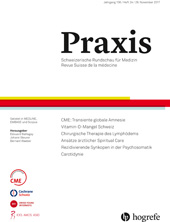Bibliografie
2017 ACC/AHA/HRS Guideline for the evaluation and management of patients with syncope: A report of the American College of Cardiology/American Heart Association Task Force on Clinical Practice Guidelines and the Heart Rhythm Society. Circulation 2017; 136: e60–e122.
, : Guidelines for the diagnosis and management of syncope. Eur Heart J 2009; 30: 2631–2637. Barón-Esquivias G, Fernández-Cisnal A, Arce-León Á, : Prognosis of patients with syncope seen in the emergency room department: an evaluation of four different risk scores recommended by the European Society of Cardiology guidelines. Eur J Emerg Med. 2016; 25 [Epub ahead of print].
Alboni P. The different clinical presentations of vasovagal syncope. Heart 2015; 101: 674–678.
, : Long-term follow-up of psychogenic pseudosyncope. Neurology 2016; 87: 2214–2219.
: Rezidivierende Synkopen in der Psychosomatik – tatsächlich psychogen?Praxis 2017; 106: 1345-1349.
: Pure autonomic failure: Predictors of conversion to clinical CNS involvement. Neurology 2017; 88: 1129–1136.
: Typical vasovagal syncope as a “defense mechanism” for the heart by contrasting sympathetic overactivity. Clin Auton Res 2017; 27: 253–261.



